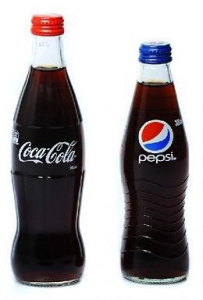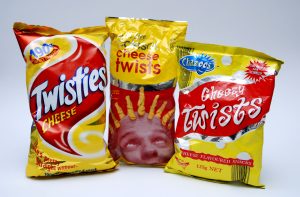Close your eyes, and give me the coke bottle
Sharon Givoni Consulting Consumer Law, Food Law, Intellectual Property, Packaging, Protecting ideas, Trade marks
How to avoid legal issues when it comes to packaging
Attention all packaging designers, this is for you. Before you launch your new product with shiny new packaging, it is important to consider whether you could be infringing someone else’s trade mark rights, engaging in misleading or deceptive conduct or passing off.
In Australia, aspects of packaging, colours and shapes are all capable as being registered as trade marks.
Take-Away Tips
- Trade mark infringement can occur even when the marks are not exactly the same.
- Even just copying aspects of someone else’s packaging could potentially be considered misleading or deceptive, or amount to passing off.
- The packaging of the products can be deceptively similar even if the brand names are different.
What is the law?
Before using a trade mark, whether it’s a colour, shape, logo or name on packaging, you should make sure that there are no similar trade marks pending or registered in Australia. Lawyers and trade mark attorneys can do these searches for you.
This requires some skill as merely searching for an identical trade mark is not sufficient. You could be infringing someone else’s trade mark by simply using a certain colour on your packaging.
Make sure to investigate the marketplace: a person can gain the exclusive right to use a trade mark through use over time, even if that trade mark has not been registered.
Another important point to note is that trade mark infringement can occur even where the marks are not identical. Sometimes, even if just elements of the packaging are similar, this could be enough to be considered misleading or deceptive conduct, or passing off the other’s reputation.
Case Study: Cigarette packaging – WD & HO WILLS v PHILIP MORRIS
In 1998, tobacco giant WD & HO Wills (Australia) Ltd took Philip Morris Ltd to court when Philip Morris launched a new cigarette brand called Summit. WD & HO Wills alleged that the packaging and associated advertising of the Summit cigarettes were confusingly similar to its own Horizon cigarettes.
Both packs featured:
- a sky blue background
- similar mountain top images
- birds and floating clouds to convey a feeling of mildness and freedom
- a similar font.
The court held that a significant number of customers might be misled into believing that the Summit cigarettes came from the same source as the Horizon cigarettes. Court orders were obtained against Philip Morris not to sell, advertise or promote its product.
Side note – this case would not have gotten very far now with the plain packaging laws introduced in relation to cigarettes, which you can click here to read more about.
Case study: Coca-Cola vs Pepsi – battle of the bottles (can you protect a contour bottle shape?)
The Coca-Cola Company took legal action against PepsiCo Inc and three related Australian companies
(Pepsi). The background facts are that:
- Coke’s contour bottle has been sold in Australia since 1937
- In August 2007 Pepsi released its own glass bottle known as the Carolina Bottle
- Coke took legal proceedings against Pepsi in the Federal Court of Australia in October 2010

The two bottles are shown above. The design brief for the Coke bottle was to develop a “bottle so distinct that you would recognize if by feel in the dark or lying broken on the ground.”
Coke argued that Pepsi’s bottle infringed its trade marks and would mislead consumers into believing that the bottles were associated due to their similar silhouettes.
The Court held in favour of Pepsi and decided that the outline or silhouette of Pepsi’s bottle was an element of its overall shape but not the only element.
There were also some differences in the bottles, for example the fluting on the coke bottle and the lack of a clear band in the middle which features on the coke bottle.
In relation to misleading or deceptive conduct, the Court took the view that there were enough differences between the overall shapes of the bottles. The Court also noted that other elements such as names and brand logos would also impact customers’ decisions on which product to purchase.
For an element of packaging to amount to passing off, a claimant has to be able to demonstrate that they have established a reputation in that particular feature or arrangement of elements.
Although in this case, Coke lost the battle of the bottles, it is important to remember that aesthetic similarities between the products are enough to put you at legal risk. Not all companies have pockets as deep as Pepsi to defend such actions.
Therefore, it is best to seek legal advice before deciding on the elements of packaging for your product as this could save you from costly, time-consuming lawsuits.
All of the above said, the below packaging for snack products have not considered too similar mainly because they use the colours yellow and red which have become generic in the industry:

What we firm can do to help you
We are able to provide labelling and packaging advice, especially in relation to trade marks.
Remember that brand names are not the only trade mark concerns and shapes, colours and scents can also be registered as trade marks. We are able to conduct the necessary searches and make sure that you will not be infringing someone else’s trade mark rights by using the elements of your choice for your packaging.
Further, if there are elements of your packaging which you want to protect as a trade mark, we are able to assist with filing and securing trade mark protection for you.
Sharon Givoni and her team regularly run seminars and workshops for educational institutions, businesses and industry associations. Packaging and labelling laws, as well as copyright are some of the areas they often present on.
Disclaimer: This article is of a general nature and not to be replaced with tailored legal advice.
